Volkswagen Transporter van review (2025)
An all-new Volkswagen Transporter that has upped the practicality and value but lost a little of its VW-specific personality
PROS
- A bigger and more spacious all-new VW Transporter
- Strong range of engines
- Great to drive
- Excellent payload potential
- Flat cabin floor
CONS
- Fundamentally very similar to the Ford Transit Custom
- Misses some of the Ford’s clever innovations
- PHEV and high roof not due until a while after launch
- Cabin feels a bit cramped
- No overhead storage
Summary
Does the 2025 Volkswagen Transporter look a bit familiar to you? In what is a big departure from its predecessors, this van was co-developed with the latest Ford Transit Custom, meaning the two vehicles are very similar to one another.
But if you are going to collaborate with a rival manufacturer then doing so on the best medium van strikes as a pretty good place to start. The challenge Volkswagen faces in the UK is to tempt buyers – the Ford Transit Custom is also the country’s most popular van, and the brand has a large and well-established dealer network with an impressive aftersales offering.
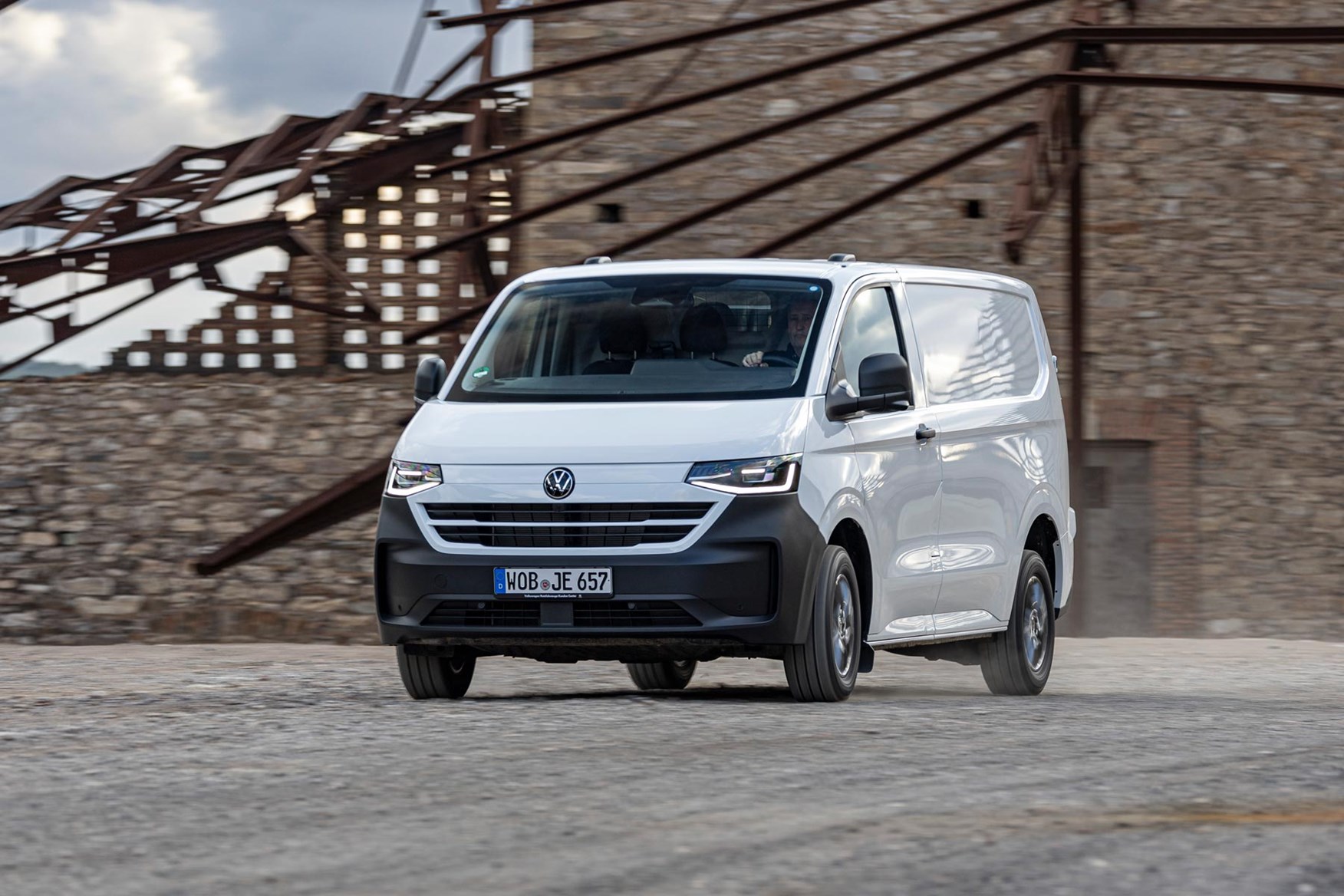
So the VW starts life simultaneously in a very good place and facing a bit of an uphill battle. This is not just a case of the VW taking someone else’s van and shoving their famous badge onto the front, though. There are plenty of factors, visual and otherwise, that make the Transporter a VW and different to the Ford.
There will still be a challenge to convince the loyal VW fans that will want some of the essence of the heritage that comes with the Transporter.
How is the VW Transporter different to the Ford?
Volkswagen has managed to put its own stamp onto the Transporter’s, both inside and out, despite being constrained by the shared construction. The front end is completely bespoke and contains several elements that are inspired by the van’s predecessors. VW says the radiator grille ‘hints at the T5’ while the headlights are styled to remind of the T6.1. The bonnet is also shorter, while there is a ‘Bulli’ line along the side of the van. There are smaller features too, such as the doors, which are bespoke to VW and have a squared off corner rather than the Ford’s curved equivalent – it’s the little details.
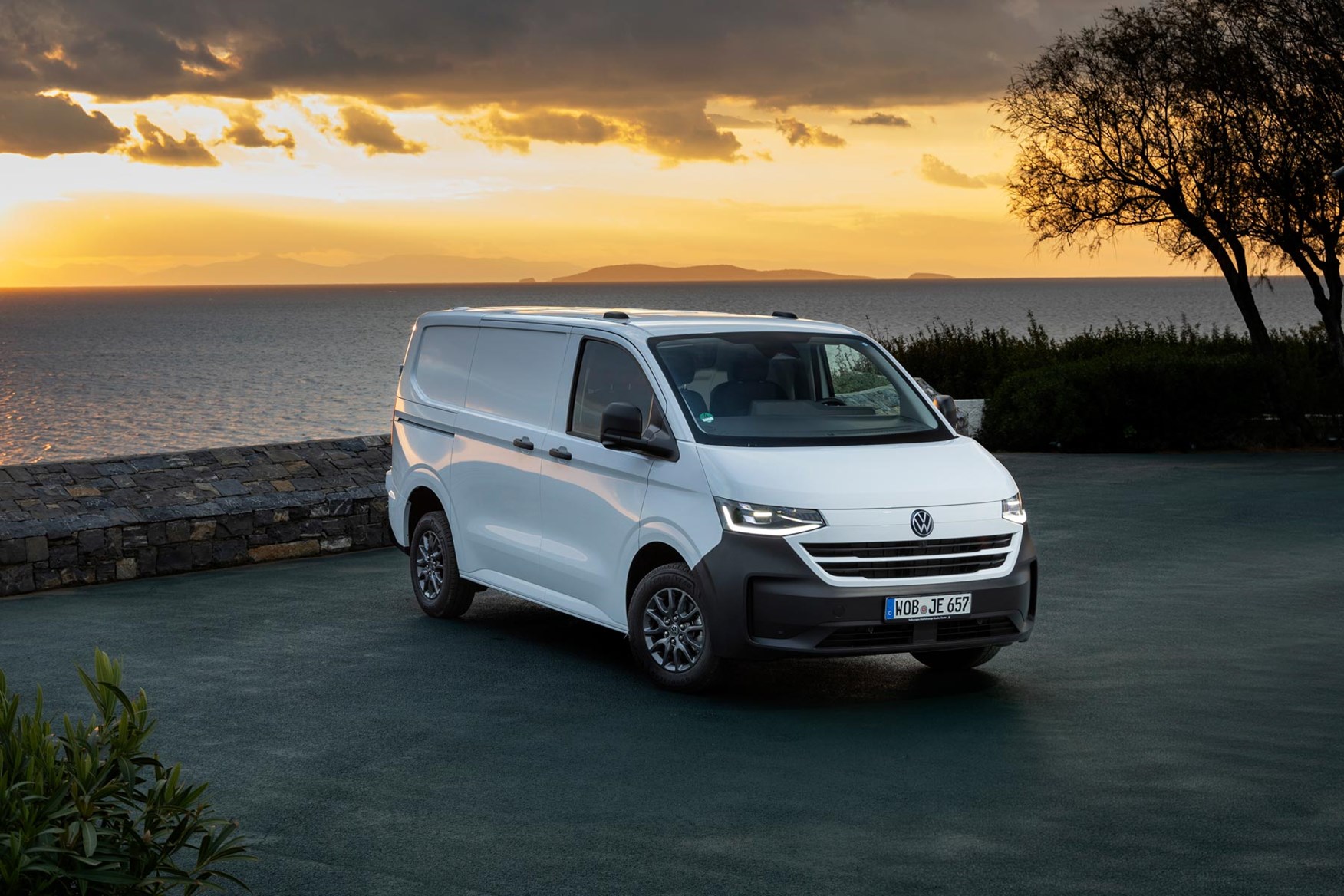
Other bits include the fact that both front and rear wheel arches are lined as standard. There’s a protective and decorative bar across the rear doors while the tail lights evoke other models in the Volkswagen Commercial Vehicles range, like the VW Amarok pickup truck.
The interior has its own twist put on it too – everything above the horizontal line running across the middle of the dash is VW’s, with relocated cupholders, a covered glovebox on the entry-level model and a Volkswagen steering wheel all present. Said steering wheel is only a standard one – you can’t get the Ford’s version that flips up to create a flat surface to eat your lunch off.
The infotainment screen is powered by a Ford operating system, but it has been reskinned so all the fonts, colours and design is Volkswagen.
What are the VW Transporter’s rivals?
What, apart from the Ford Transit Custom you mean? Have I mentioned that one already? Apart from that, it is the usual suspects of the mid-size van class. This includes the Mercedes-Benz Vito, the Renault Trafic and Nissan Primastar.
There is also the Stellantis quartet – the Citroen Dispatch, Fiat Scudo, Peugeot Expert and Vauxhall Vivaro – and the fundamentally identical Toyota Proace.
Then there are some of the newcomers from the lesser-known brands, like the electric-only Maxus eDeliver 7.
Verdict: is the 2025 Volkswagen Transporter any good?
Yes, the Volkswagen Transporter is an excellent van, certainly as good as the Transit Custom, which was up to this point the best in class. Whisper it, but I can even see justifications to go for the VW instead of the Ford.
The VW is fractionally cheaper, and there are elements that you might prefer if you are of a VW persuasion. The differences are marginal, though, but given the excellence of the Ford this isn’t the worst thing in the world.
Skip to our full verdict on...
- Car-like to drive
- Great turning circle and visibility
- Light steering
The Volkswagen Transporter has grown in almost every direction, but VW has worked hard on its manoeuvrability to ensure that it is easy to get around town. That low roof height helps, but the turning circle and light steering both help when it comes to squeezing into tighter spots.
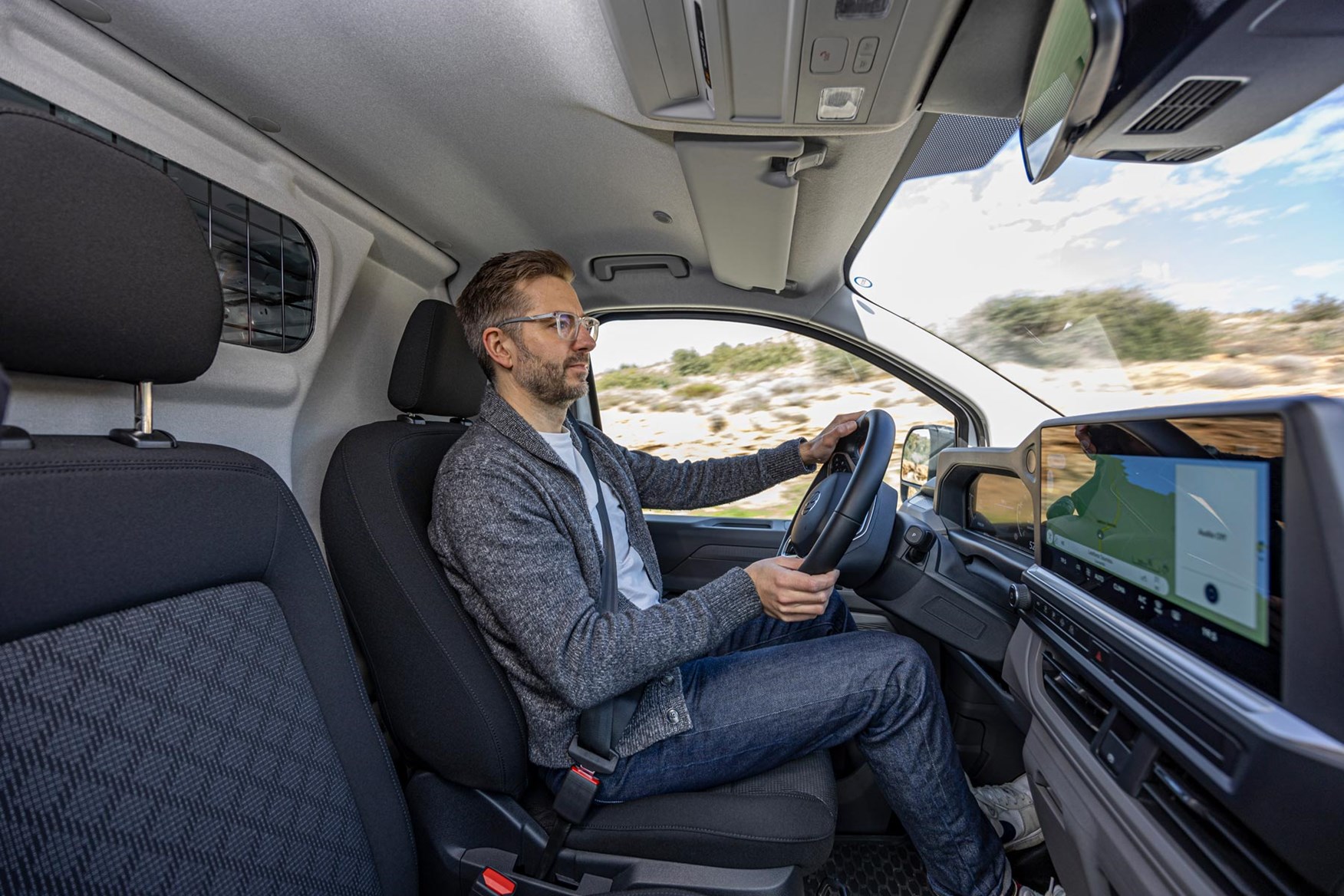
The turning circle is 11.8m on the shorter model, which is less than a metre more than the Golf hatchback. The longer version isn’t much bigger, being able to get around in 13.0m.
This is aided by a light steering setup that means you can dart in and out of town spots without feeling like you are hauling the wheel around to do so. This is great for these urban parking moves, but it does mean that there isn’t some of the solid and connected feel of vans gone by – it’s more useful, but it does dial back the enjoyment and satisfaction of driving a little.
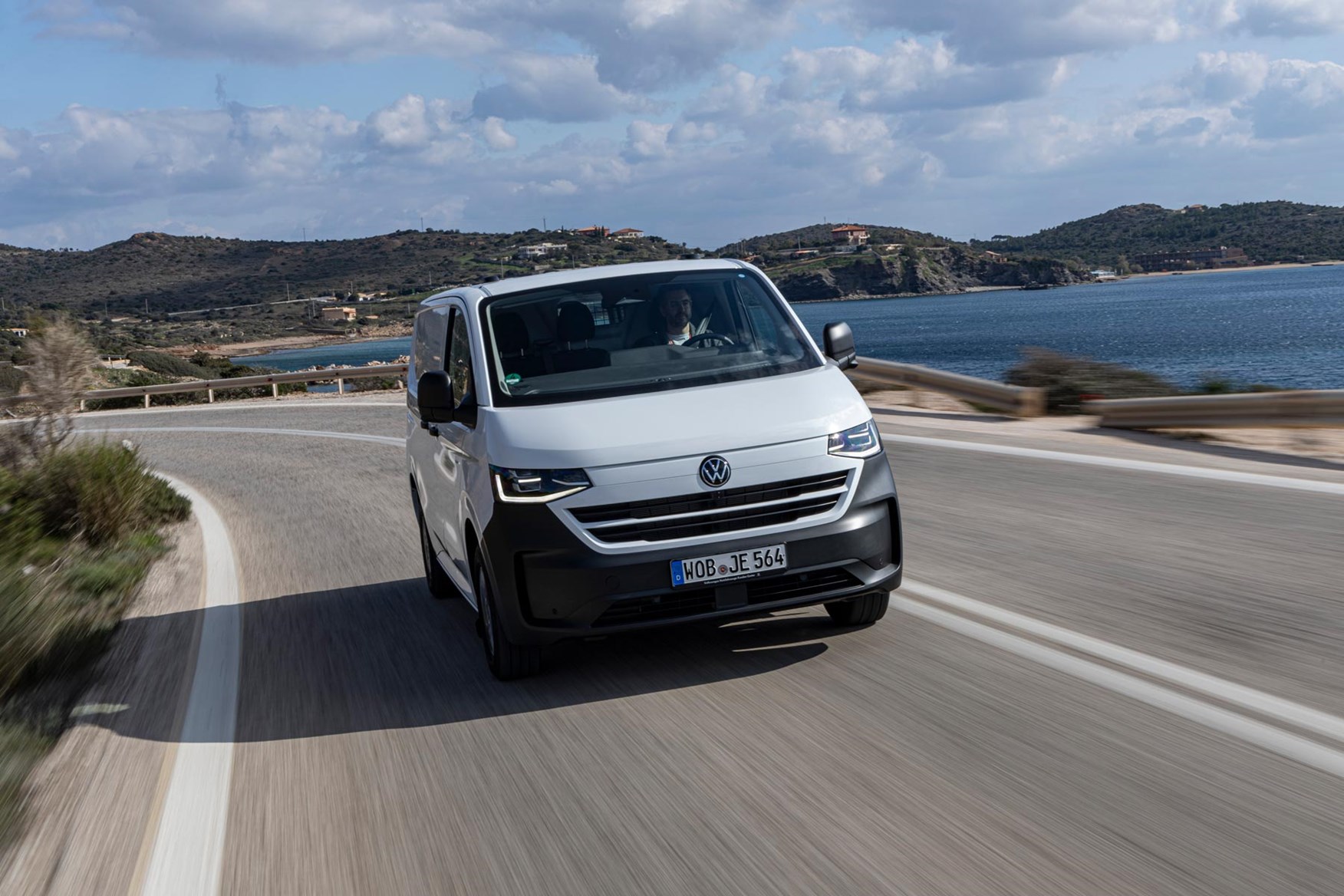
The Transporter rides fantastically, too, dealing excellently with the few bumps and imperfections on the test routes. All the Transporters I tried were empty, which usually removes some of the smoothness, but it still managed to feel remarkably composed. It does mean we haven’t had a chance to try it out with a heavy payload, though.
What engines and gearboxes does the Volkswagen Transporter come with?
There are three diesel engines in the VW Transporter range, all of which are familiar ones. They aren’t VW units, though – these are the same three as feature in the Ford Transit Custom, which were in themselves carried over from that van’s predecessor.
This means they are tried and tested, but not the latest modern engines they could be. There have been minor tweaks since they first appeared, and it is this that contributes to the fuel efficiency improvements.
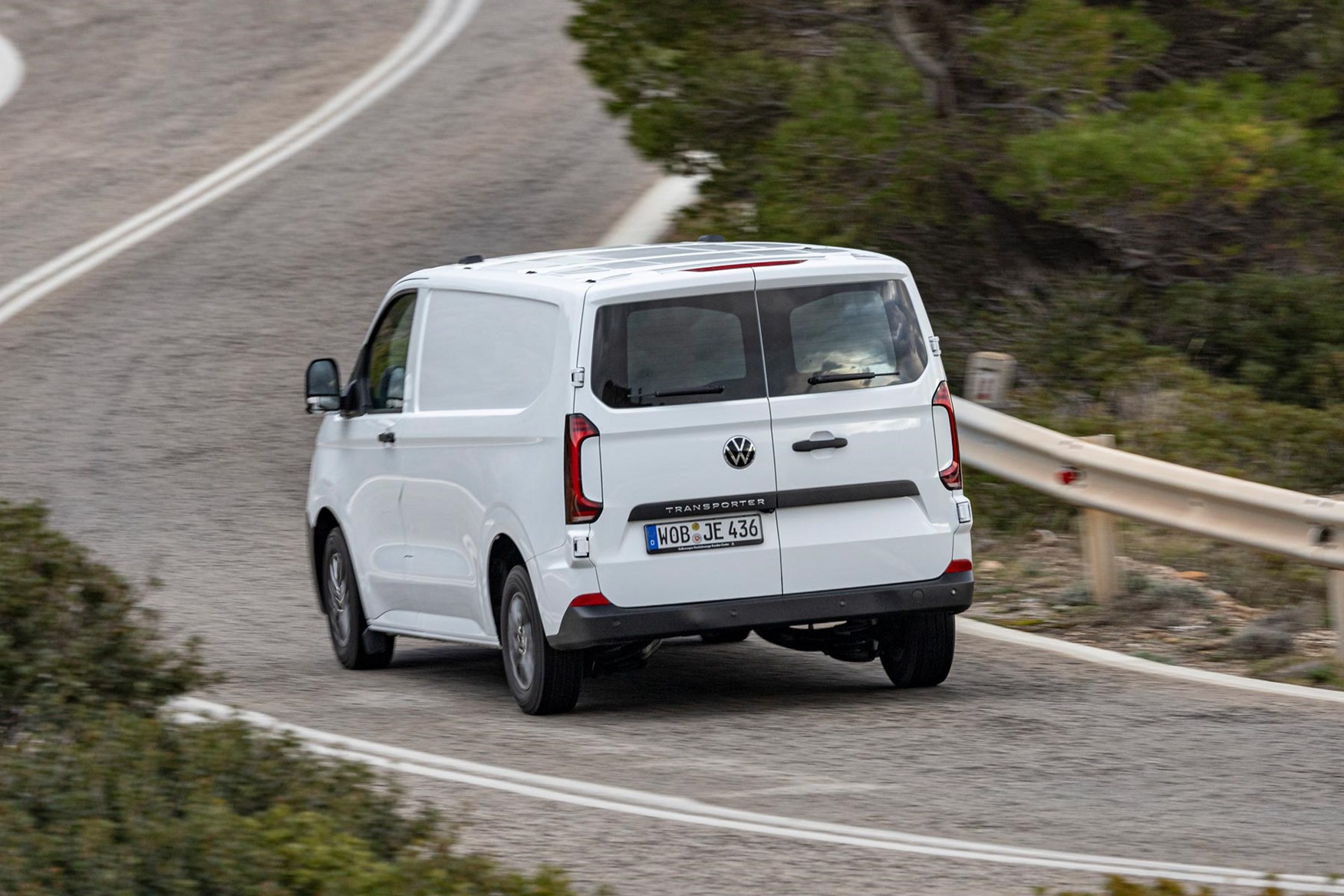
All three engines are 2.0-litre diesels, with 110hp, 150hp and 170hp. So far I have only tried the most powerful of these three, which naturally felt completely unphased by the challenge of hauling around an empty Transporter. It was paired to an eight-speed automatic transmission, which is smooth and controlled by a stalk selector that is up behind the steering wheel.
There is no means of manually shifting the gears but there really is no need to – just leave it be and it is a smooth and seamless experience.
Visibility
The big windows mean it is easy to see out of the Transporter, and the short bonnet makes it simple to see the extremities of the van, all of which is great for urban parking. The VW has a fractionally squarer window than the Ford, but in reality the bit of extra glass is in the bottom corner closest to the back of the van, so it doesn’t make a practical difference.
Rear parking sensors come as standard on every version, while the mid-range Commerce Plus adds front sensors and a rear parking camera, which is a great low point for it to arrive.
- Low cabin roof
- Excellent floor design
- Driver-focused dashboard
Volkswagen has been able to make the interior its own, with everything from the mid-dash belt line and upwards bespoke to the Transporter. This means that there are some small but handy differences on the top of the dash – the cup holder on the driver’s side is closer to the windscreen rather than right by the door for example, while the open storage area is slightly larger.
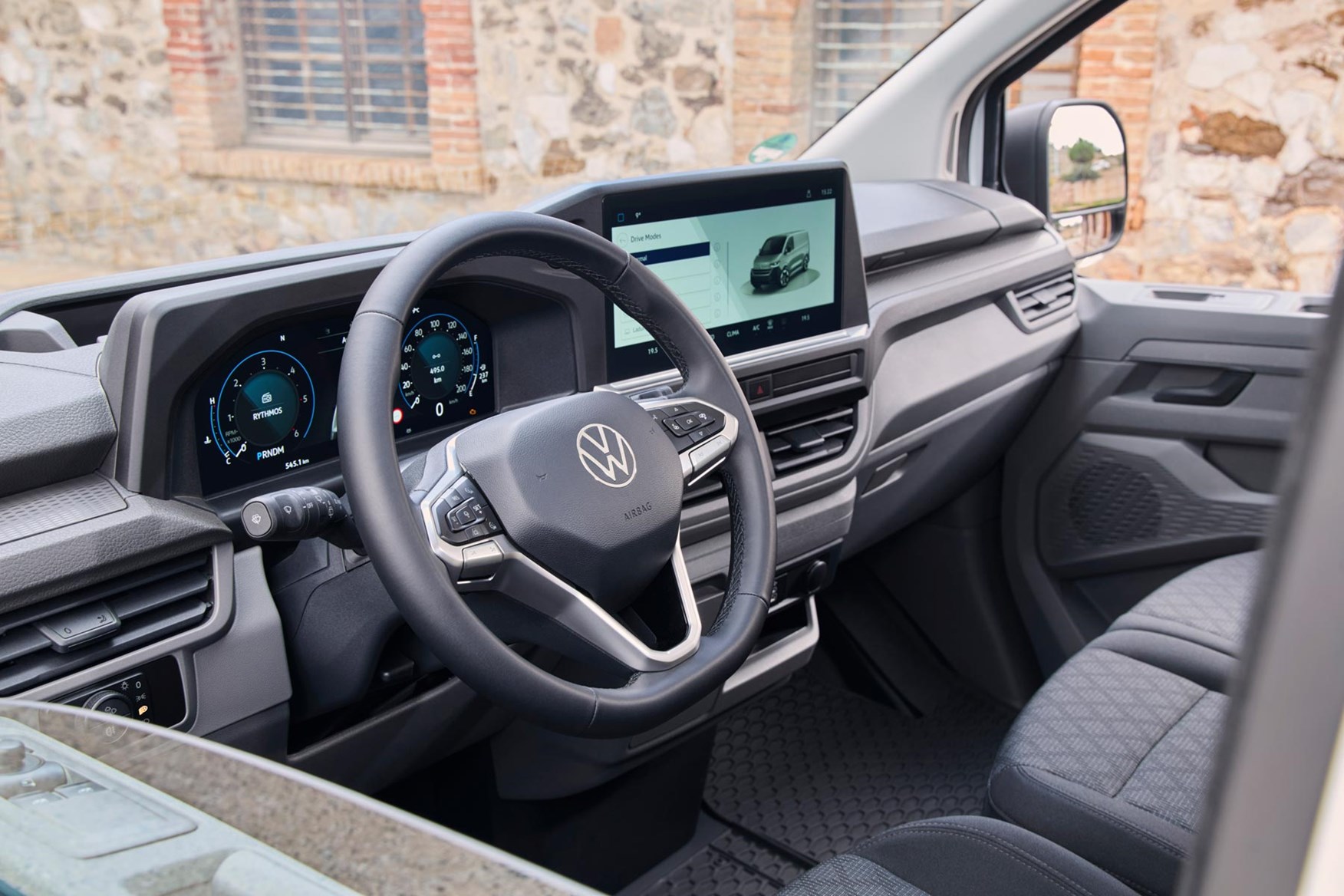
Then the glovebox on the passenger side comes with a secure lid on all trims, whereas on the basic Ford it is left open. Those cupholders are still quite high up and therefore in the bright sunshine, which will heat up your water in the summer faster than if they were lower down. They aren’t very deep either.
The steering wheel is one of VW’s too, which makes it feel like a Transporter but it also means it loses out on the clever but slightly gimmicky function in the Ford that allows you to tilt the outside of the wheel flat to turn it into a little table. There is still a little surface on the back of the middle seat that you can fold down to use as a mini desk, though.
One other seemingly small touch – the little pocket near the top of the door has a grippy surface to stop the
Smart infotainment as standard
All versions of the Transporter come with a 13.0-inch touchscreen as standard, with smartphone pairing for Apple CarPlay or Android Auto. You only get wireless charging on the top-level model, though, so you might well need to take a phone cable with you regardless.
The basic model gets a couple of slots for you to charge said phone – a modern USB-C sits alongside a USB-A slot, for those with older cables. These sit down in the dash near the phone slot, which allows you to tuck your phone slightly out of the driver’s eye line. There are more USB-C connections on higher models, again out of sight and up in the top storage boxes.
The screen’s operating system is Ford’s, but VW has reskinned it so that all the fonts, designs and features are bespoke.
Thankfully, there are also some physical buttons down below the screen and on the steering wheel, VW having realised that not everyone likes the haptic touchscreen controls that you have to take your gloves off to use.
Flat floor makes for ease of access
The flat cabin floor is a fantastic feature, as it allows you to shuffle across from one side to the other without having to climb over a raised bump in the middle. It also means that a central passenger gets more legroom, particularly in the automatic model where the gear selector is up on a stalk by the steering wheel rather than in a conventional position on the dash. There really is space for three adults in the Transporter, and without the middle one feeling like the poor relation.
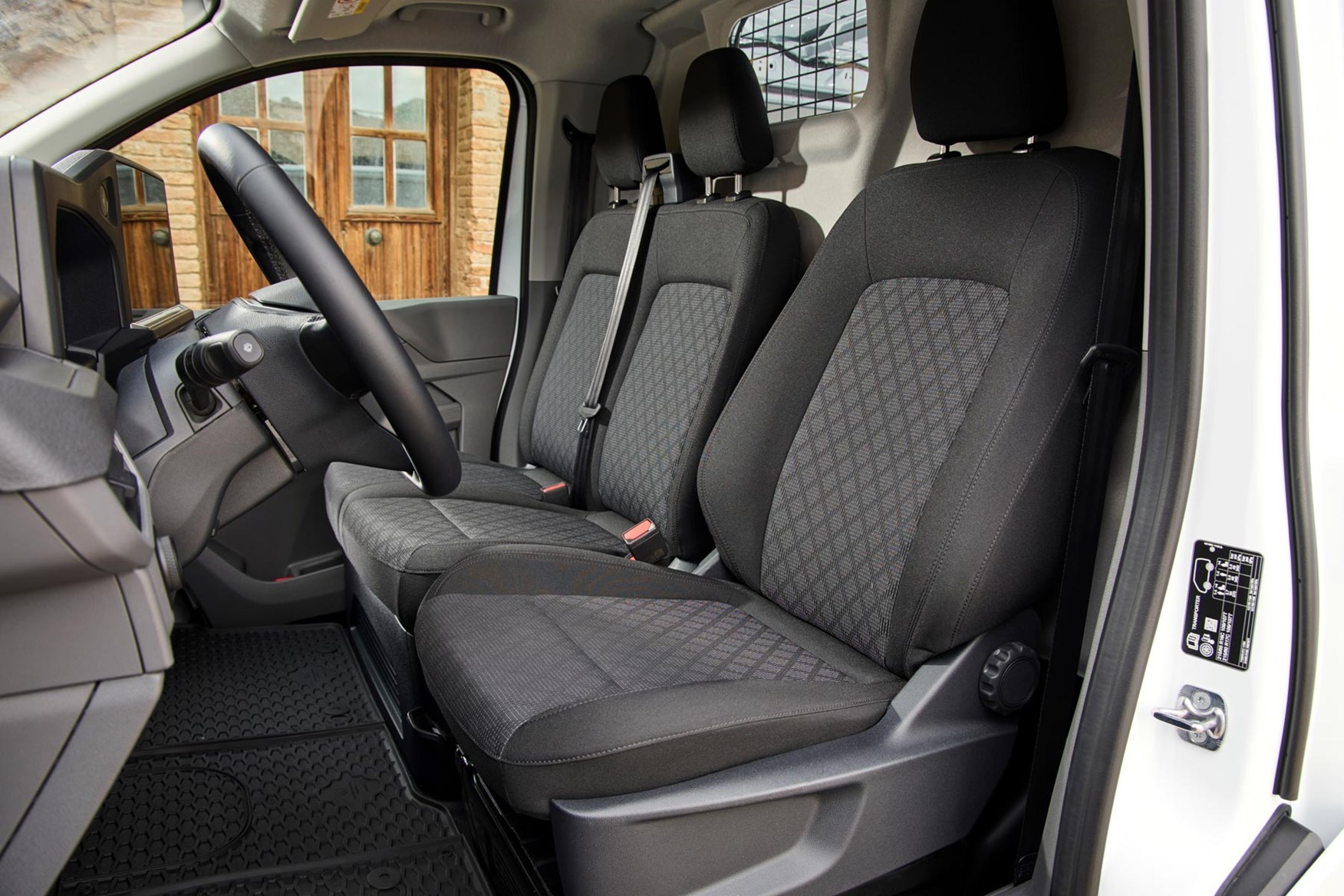
The one downside of a car-like cabin is that there isn’t much height up top. Not only does this result in a slightly more cramped feeling than some might be used to in a van but it also means there is no overhead storage for stashing maps or folders.
- Fractionally cheaper than its Ford equivalent
- Three trim levels to start off with
- Excellent 5+ Promise package
There was no way that Volkswagen was going to be able to drastically undercut the Ford Transit Custom with the Transporter, but it has managed to make a few savings here and there. The entry level versions are around 4% cheaper than the Ford equivalent with a similar level of kit – in fact the VW has a couple of extra bits, such as air conditioning, LED headlights from standard and little features like extra rubber in the top compartment in the door to stop your keys sliding around. It’s the little things.
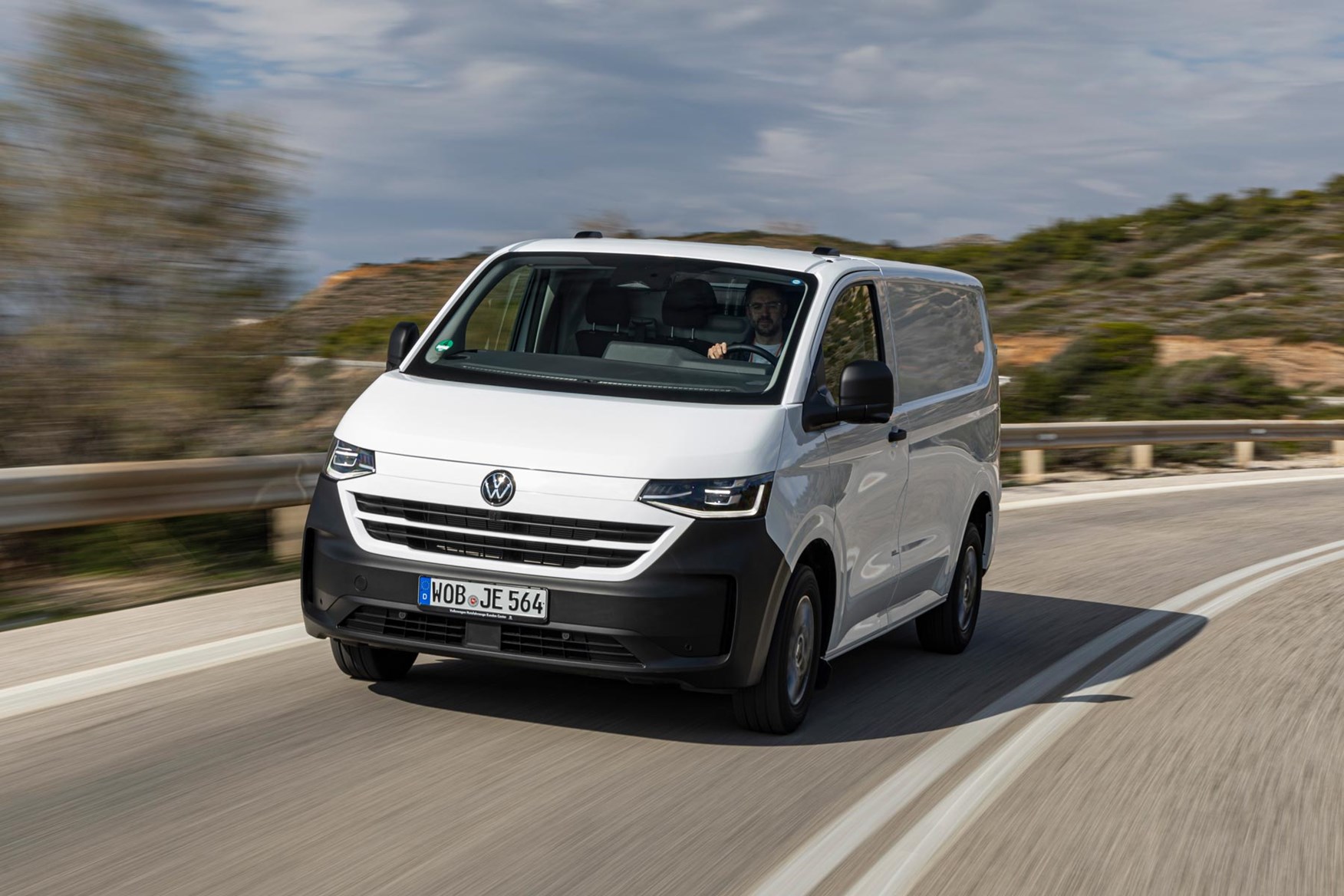
The other handy money saver comes in the form of the 5+ Promise, which brings a longer warranty, five years of servicing, the first MoTs and five years roadside assistance. This is all included at no extra cost, too.
Volkswagen Transporter mpg
Most of the VW Transporters are in a similar ballpark when it comes to economy, with the most efficient version offering a maximum official figure of 40.9mpg. To get this you need to go for the manual version of the 110hp 2.0-litre TDI.
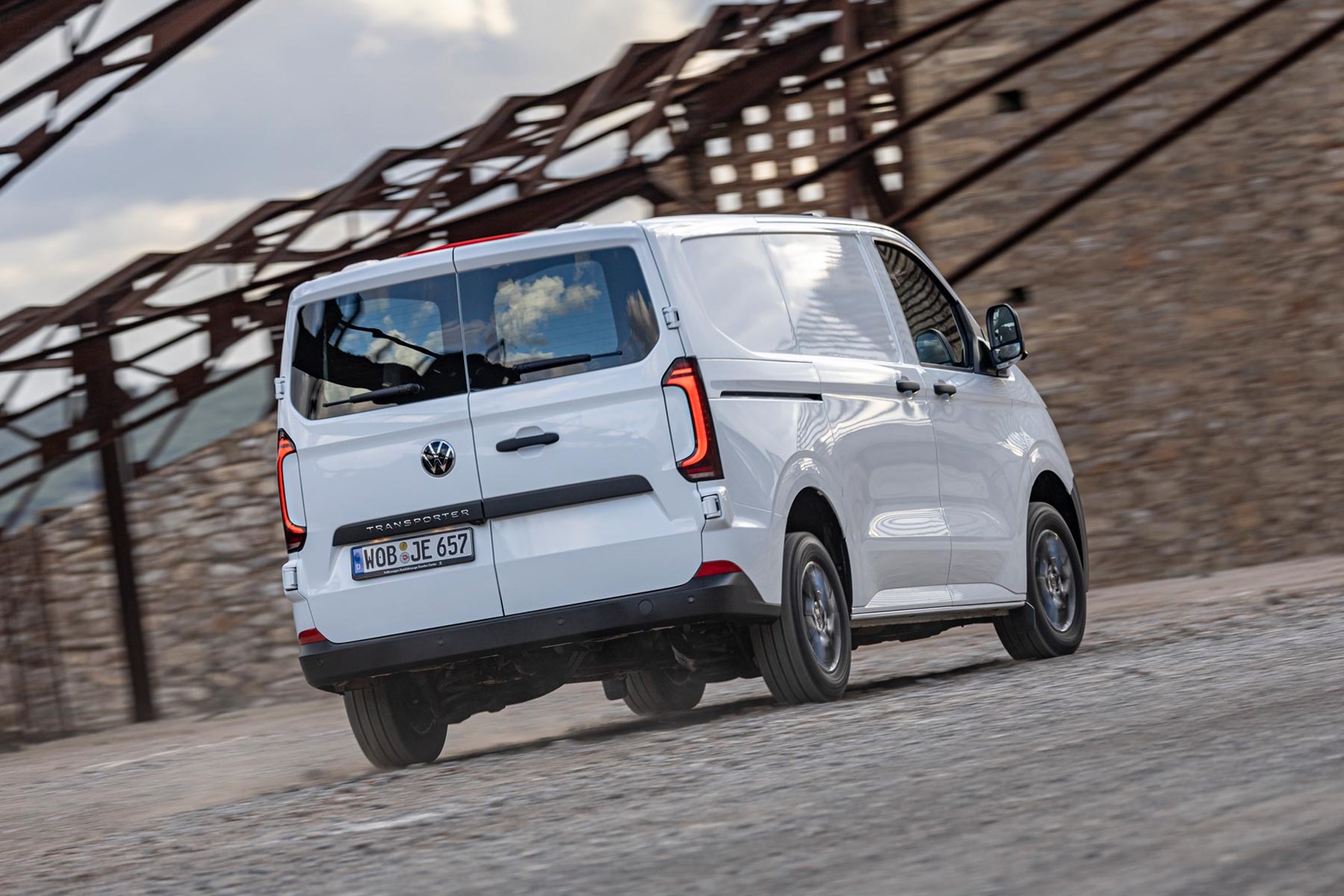
However, the 150hp model isn’t far behind with an official economy rating of 40.4mpg, so long as you go for the manual gearbox – the auto manages 37.7mpg at best.
The outlier in the diesel range is the four-wheel-drive 4Motion model, which only manages 33.2mpg at best.
2025 Volkswagen Transporter servicing
Buyers of a new Transporter won’t have to worry about servicing costs, as VW will look after the first five services. These have to be carried out every two years or 25,000 miles.
2025 Volkswagen Transporter warranty
Volkswagen’s 5+ promise brings five years or 124,000 miles warranty cover. This is longer than plenty in the industry.
2025 Volkswagen Transporter standard equipment
There are just the three trim levels on offer in the VW Transporter range to start off with – Commerce, Commerce Plus and Commerce Pro. Sadly, the UK doesn’t get the PanAmericana version that played a part in the van’s launch, and which also features on the Amarok pickup truck. However, with Ford offering an off-road-style Trail model on the Transit Custom, don’t be surprised if it joins the range later.
2025 Volkswagen Transporter Commerce equipment highlights:
- 16-inch steel wheels with Goodyear summer tyres
- Black radiator grille and front and rear bumpers
- Powered and heated door mirrors
- Two-seater passenger bench seat with load-through hatch
- Two arm rests for driver’s seat
- Six-way adjustable driver’s seat with lumbar support
- Rubber floor covering in the cabin
- 0-inch digital driver’s display
- 0-inch touchscreen with wireless Apple CarPlay and Android Auto
- 5G modem
2025 Volkswagen Transporter Commerce Plus equipment highlights:
- Body-coloured grille, front and rear bumpers, mirrors and door handles
- Leatherette steering wheel and gear lever
- Keyless start
- Rear-view camera
2025 Volkswagen Transporter Commerce Pro equipment highlights:
- 16-inch alloy wheels
- Laminated and heated front windscreen
- Heated front seats
- Automatic air conditioning
- LED lighting in cargo area
- Wireless phone charging
- Established engines
- Good warranty and breakdown assistance to provide backup
There is no point looking at older versions of the Volkswagen Transporter for a guide on how this one will perform – this one uses a Ford engine and gearbox. These engines have been around for a while and were carried over from the previous version.
The latest list of the UK’s most reliable vans makes for reassuring reading, with the Transit Custom rising one place to fifth. The VW Transporter’s five-year free breakdown cover and extra warranty will offer more peace of mind too.
- Top-level platinum safety rating
- Not everything included as standard
Euro NCAP has awarded the Volkswagen Transporter the highest rating possible, giving it a Platinum award and a 96% score. Safe to say it comes with a fair amount of safety kit then.
However, VW doesn’t go down the line of throwing absolutely everything at the entry-level model, holding a few things back for the Commerce Plus and Commerce Pro. That said, the kit it adds at those levels are more the sort of items that make life easier, rather than being crucial to driver safety. Think things like a rear-view camera, adaptive cruise control, lane keep assist and cross traffic assist.
2025 Volkswagen Transporter Commerce safety equipment highlights:
- Cruise control with predictive speed limiter
- Driver and front passenger airbags, curtain airbags
- Front collision warning with braking
- Lane assist
- Rear parking sensors
- Road sign display
- Emergency eCall system
The Commerce Plus then adds towing protection, front and rear parking sensors and a rear-view camera. Commerce Pro brings adaptive cruise control with a predicted speed limiter, cross traffic assist and lane assist with blind spot assist and an exit warning system.
2025 Volkswagen Transporter Commerce security
The entry-level Transporter comes with an immobiliser, but you have to go up to the Commerce Plus to get an alarm, which is a shame.
Which Volkswagen Transporter (15-24) is best for me?
Volkswagen has kept the Transporter’s trim range comparatively simple, with just the three on offer. All are fairly well equipped, and you would do well enough with the entry-level model. It can look a bit basic, with its black bumpers and exterior details, so it’s totally understandable if you want to step up to the much smarter looking Commerce Plus.
Engine wise, VW reckons the biggest seller will be the 110hp, but with the mid-range 150hp growing in popularity. We’ve only driven the most powerful engine in the VW, but experience with the 150hp model in the Ford Transit Custom suggests it is a sweet spot in the range.












